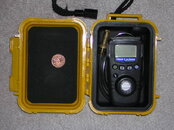I've looked at every portable CO tester mentioned in this thread and I will purchase one... however none of them are great for divers. At the very least they all seem very prone to environmental issues and all seem to have been the result of modifying a product the company already produced so that is was kinda tweaked for divers.... but the bottom line is simple... none of them are really developed for divers. I just can't understand why with the amount of money divers are willing to spend on diving gear and travel they wouldn't pay the additional money to insure they have good air.... look at what we as an industry spend on dive computers to insure the safety of dive table theories. Air quality on the other hand is 100% pure proven science and is frankly very basic science. My point is simple: The industry needs a quality product / solution that can grow legs and become main stream. CO and Oxygen testing has been around for years but has never been integrated / developed into a practical diving solution for recreational divers. I'm actually considering taking action on this issue after my Cozumel adventure. I sold my companies about 1 1/2 years ago and it is time for me to start something new. I've always played in the electronics arena and my family still owns a small contract electrical manufacturing plant that with minimal efforts may be able to get a product designed and prototyped for the diving industry... and with a little luck get a vendors excited to manufacture the product at a good cost point so that it has the opportunity to grow some legs and make diving safer.
Over the last decade or so many business have tried to develop a diver specific CO device and they have all failed generally because the market is too small or they were not able to solve the calibration service cost and access issue which is the current stumbling block to widespread dissemination of this portable electrochemical sensor technology.
Back in the nineties there was a device called the Air Guard made by Seaways Engineering which plugged directly into the lp hose and used a Drager tube for CO detection. Not sure what happened to that company but the device didn't last long on the market at $100. Cost per tube was $3 and they could only be used once.
The CO-Cop was a reasonable device for the early nineties but it relied too much on interpretation of different shades of beige and while it would protect against gross contamination there were problems in the < 10 ppm range. It is no longer available and electrochemical sensor technology has supplanted this colorimetric technology.
Around 2005 a company called Tekair developed a very nice monitor modeled on the BWT Gas Alert Extreme which was diver specific (see photo). The company was at DEMA and spent a ton of cash marketing the $200 device only to go belly up a year or two later. Again they could sell the monitors but it was the ability to get the units calibrated which killed the business plan. Most sport divers were not willing to shell out another $200 at the time to purchase a regulator and tank of calgas.
The BWT Gas Alert Extreme is the same unit as the Tekair diver unit but with a few more features hence the higher price. Now that the ToxiRae 3 is available for $150 this unit is ideal for divers. Other than packaging it with a flow restrictor and putting it in a Pelican 1010 case this unit is very reliable, small, favorably priced, and as close to a diver specific unit as one could hope for. I have spoke to the manufacturer and the margins on these are razor thin. They make their money selling one hundred of these units at a time to mining companies and other industrial operations. Because the dive market is much smaller expect the Analox unit whenever it comes out to be significantly more expensive than $150.
Analox is still going to have to solve the calibration issue before they bring a portable CO monitor to the sport diver market. I'd be very curious to hear what Patti at Analox has to say on the issue of calibration. As mentioned previously if Analox was able to sell a CO Clear fixed monitor to a dive fill station in every major city there would then be a network of shops where individual divers could take their portable units for regular calibration prior to heading south. The CO Clear uses 10 ppm CO calgas and the shop would own the calibration equipment and offer calibration service to the individual diver for a small fee.
Having DAN and/or PADI encourage compressor fill station operators to purchase the CO Clear or similar fixed CO monitor would establish such a network and solve the calibration service access issue quickly and simply. It is really DAN and the training agencies which hold the answer to a systemic fix for this CO compressed gas contamination risk in the dive industry.




